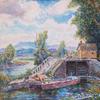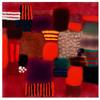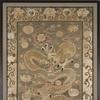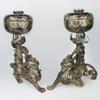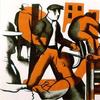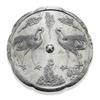Exhibition Explores Hiroshige's Famed Series '53 Stations of the Tokaido'
- NEW YORK, New York
- /
- April 05, 2017
This May, Ronin Gallery invites you to explore a familiar path from a new perspective. The exhibition 53 Stations of the Tokaido Road: a.k.a. the Upright Tokaido (1855) journeys down the most traveled road in old Japan. In this series, Hiroshige captures the distinctive beauty of each station with innovative use of vertical space. Known for its plentiful views of rivers and the sea, the Upright Tokaido presents both Hiroshige’s romance of the Japanese landscape and his bold eye for composition.
Tracing the eastern coast of Japan, the Tokaido attracted travelers as early as the 8th century. In the early 1600s, ruling power shifted from the emperor to the shogun, inviting an unprecedented level of activity on the road. By 1689, fifty-three stations connected the eastern capital of Edo (modern Tokyo), the seat of the shogun, to the imperial capital of Kyoto, the home of the emperor. The Tokaido was the most traveled road in Japan: this 323-mile artery provided the main infrastructure for trade and communication until the arrival of railways during the Meiji period (1868-1912). Through changing seasons and creative viewpoints, the 1855 series 53 Stations of the Tokaido guides the viewer through each station of this historic road, providing a window into Edo-period culture.
Born in Edo in 1779, Hiroshige is revered as the “poet of travel.” He grew up in a minor samurai family and his father belonged to the firefighting force assigned to Edo Castle. While he entered his apprenticeship in 1811, Hiroshige’s artistic genius went largely unnoticed until 1832 and his first Tokaido Road series. In 1858, at the age of 61, he passed away as a result of the Edo cholera epidemic. However, the legacy of Hiroshige’s work had a profound influence on European Impressionists and Post-Impressionists: Toulouse-Lautrec drew inspiration from Hiroshige’s daring diagonal compositions and creative use of perspective, while van Gogh directly copied two prints from 100 Famous Views of Edo in oil paint.
The Ronin Gallery is a leading family-owned Japanese and East Asian art gallery in New York City and home to the largest private collection of 17th–21st century Japanese prints for sale in the United States. Founded in 1975 in the Explorers Club Mansion of New York City, the gallery is now located on Madison Avenue and 49th Street. For more information about the gallery and to access the gallery’s online exhibits, visit: www.RoninGallery.com.




10270x400_c.jpg)


